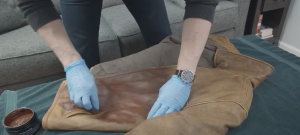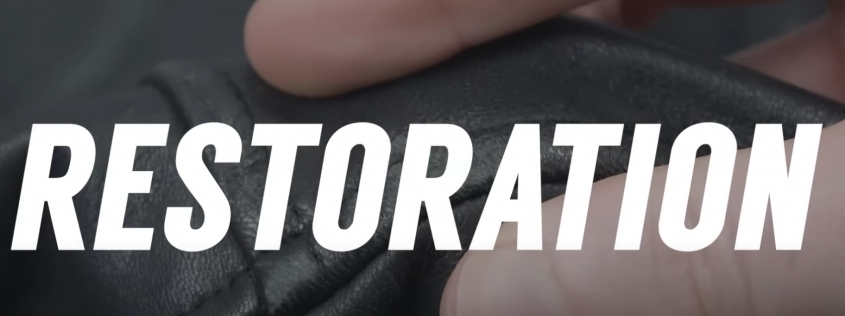Restore & Renew Clothing Vs Buying New!
 Restoring and renewing clothing, particularly items made from materials like leather, can help extend their lifespan and maintain their appearance. The first step in restoring any piece is thorough cleaning. For leather garments, use a soft cloth or sponge and a gentle leather cleaner or a mixture of mild soap and water to remove dirt and grime. Always test the cleaner on an inconspicuous area before applying it to the entire piece. After cleaning, allow the leather to air dry naturally—avoid using direct heat sources like hair dryers, as they can cause the material to dry out or crack.
Restoring and renewing clothing, particularly items made from materials like leather, can help extend their lifespan and maintain their appearance. The first step in restoring any piece is thorough cleaning. For leather garments, use a soft cloth or sponge and a gentle leather cleaner or a mixture of mild soap and water to remove dirt and grime. Always test the cleaner on an inconspicuous area before applying it to the entire piece. After cleaning, allow the leather to air dry naturally—avoid using direct heat sources like hair dryers, as they can cause the material to dry out or crack.
 Once cleaned, moisturizing and conditioning the leather is essential. Leather tends to lose its natural oils over time, leading to stiffness and cracks. Apply a leather conditioner or cream designed to replenish moisture, working it into the material with a soft cloth in circular motions. This helps to restore the suppleness and luster of the leather. For clothing made from fabric, consider using a fabric softener or specific conditioner designed for the material.
Once cleaned, moisturizing and conditioning the leather is essential. Leather tends to lose its natural oils over time, leading to stiffness and cracks. Apply a leather conditioner or cream designed to replenish moisture, working it into the material with a soft cloth in circular motions. This helps to restore the suppleness and luster of the leather. For clothing made from fabric, consider using a fabric softener or specific conditioner designed for the material.
For deeper repairs, such as scratches, scuffs, or stains, a leather repair kit can be useful. These kits often come with filler compounds such as resolene fiebings and color matching dyes that allow you to restore minor damage. For fabric clothing, small holes or rips can be mended using fabric glue or a sewing kit, depending on the size and location of the damage.
Additionally, regularly maintaining your clothing through proper storage is key to prolonging its life. For leather, store garments in a cool, dry place away from direct sunlight to prevent fading and deterioration. Use padded hangers for jackets and coats to preserve their shape, and for fabric clothing, ensure it is washed according to care instructions to avoid wear and tear.
By following these simple steps—cleaning, conditioning, repairing, and proper storage—you can significantly extend the life of your clothing and keep it looking fresh and revitalized.
If You Can’t Restore, Consider Donating
Donating clothes can save a significant amount of landfill space compared to throwing them away. According to various studies, including data from the Environmental Protection Agency (EPA), approximately 85% of textiles in the U.S. end up in landfills or incinerators each year. In 2018, the EPA estimated that around 17 million tons of textile waste were generated in the United States alone, and most of this waste could have been recycled, reused, or repurposed.
When you donate clothes instead of tossing them, you help divert those items from landfills, where they would otherwise take up valuable space and contribute to environmental degradation. While the exact amount of landfill space saved can vary depending on the material and the volume of clothing, the broader impact is significant. For example:
- Clothing is bulky: Textiles, especially items like coats, sweaters, and jeans, are large and take up a considerable amount of space in landfills. Donating just one large bag of clothes can prevent multiple cubic feet of waste from filling up landfill space.
- Textiles can take years to break down: Some fabrics, like synthetics and blends, can take hundreds of years to decompose fully in a landfill. While natural fibers like cotton, wool, or silk decompose more quickly, even they contribute to landfill mass.
- Reuse reduces demand for new resources: Donating clothes extends their lifecycle, which reduces the need for new garments to be produced. This indirectly helps reduce the demand for raw materials, such as cotton, oil (for synthetics), and water, which are needed to manufacture new clothing. The production process for new clothes is resource-intensive and contributes to environmental issues like water pollution and carbon emissions.
Environmental Benefits of Donating Clothes
- Landfill space: Each ton of textiles that is diverted from landfills is equivalent to saving about 3.6 cubic yards of landfill space.
- Energy and resource savings: Donating clothes also helps reduce the energy and resources required to make new items, lowering overall environmental impact.
Practical Impact
If every American were to donate one additional garment per year instead of throwing it away, it would result in millions of tons of clothing being kept out of landfills. In 2020, it was estimated that 92 million tons of textiles were thrown away globally. If just a fraction of these items were donated instead, it could result in a substantial reduction in landfill waste.
In summary, donating clothes not only saves significant landfill space but also contributes to a circular economy by reusing materials, conserving resources, and reducing the overall environmental impact of textile waste.

